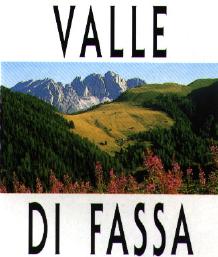

Every day a magical atmosphere surrounds everyone and everything among these
mountains. As day turns into night, or darkness clashes with daylight,
when the sun's rays slide obliquely on the horizon, the Dolomite mountains
are white at dawn and tinged fiery red at sunset. This is the eternal and
always new spectacle of the Enrosadira, a prerogative of these mountains
certanly among the most beautyful in the world.
Valle di Fassa means the Dolomites: from Marmolada, the Queen of the Group
to Catinaccio, the elected and legendary home of King Laurino, and Sassolungo
just to name the most important ones. Magical mountains mentioned in many
legends still narrated to children today when they can be enticed from the TV.
Mountains inhabited by Ladins, that proud population who have been the owners
of the Dolomites for two thousand years and are now the ethnic minority
whose language, culture and traditions are protected.
The Monti Pallidi, that rose out of the sea 250 million years ago and were
turned into the most beautyful constructions in the world by the ice and
wind (so the architet Corbusier described them), have brought development
and prosperity to the Fassa population and the side valleys radically
altering their destiny.
At a time when the mountains are being rediscovered, together with the concept
of cleaness and conservation, the Dolomites continue to represent the maximum
for anyone who wants an alpine holiday.
This is the basis of reasoning behind Valle di Fassa's vertiginous tourist
development in the last decade, where half a million holidaymakers spend 4
million days per year.
In a dozen or so villages, of which the largest are Moena and Canazei,
modern accommodation structures and facilities have had a decided effect
on the market, together with a very varied offer.
The countryside, environment and nature head the list of preferences
among visitors. However, after an outing, it is undoubtedly worth
visiting the Ladin Museum in Vigo di Fassa in which records and object
of the life and culture of the Ladin Dolomite population are arranged
in various setions.
The Museum represents and preserves a heritage of history and values that
has remained unaltered in the course of the centuries.

